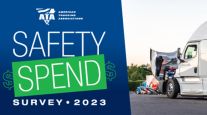EPA Urges Better Monitoring of SCR Emission Systems
This story appears in the June 13 print edition of Transport Topics.
The Environmental Protection Agency last week updated its guidance for certification of heavy-duty truck engines using selective catalytic reduction to reduce emissions, rejecting claims made last year by truck maker Navistar Inc. that the technology can be easily defeated.
The new guidance, issued partly to satisfy a federal lawsuit settlement agreement last year between EPA and Navistar, urges SCR engine manufacturers to continue improving warning systems that alert drivers when a truck’s diesel exhaust fluid tank is low or empty, or filled with “incorrect or poor-quality agent.”
Diesel exhaust fluid, a urea-water solution, is an essential component of SCR, enabling the system’s catalytic converter to remove nitrogen oxides from exhaust. All U.S. engine manufacturers but Navistar use SCR, and Navistar has argued in several forums that its exhaust gas recirculation system is better.
EPA’s guidance calls on OEMs using SCR to review design elements that would make tampering with the proper operation of SCR systems “impossible or highly unlikely.”
Testing of SCR systems has largely yielded positive results, EPA said.
“On-highway heavy-duty SCR systems introduced into commerce to date have been highly successful in inducing operators to refill DEF tanks on a timely basis and to avoid interfering with SCR operation, with a few specific exceptions,” EPA stated. “The strong indication from all of this evidence is that DEF warning systems are working correctly, and that, when warned, drivers have not continued to drive distances long enough to lead to inducements.”
Yet, the agency said, it “believes it is appropriate to refine its guidance.”
EPA is seeking public comment on the draft guidance until July 7. It plans to issue final guidance by the end of this year.
The EPA draft guidance is an update to guidance issued by the agency in 2007 and 2009.
Navistar has attacked SCR technologies aggressively, both in the marketplace and in the federal court system, where it argued that EPA’s guidance was faulty.
Last year, Navistar said an independent study it commissioned showed that SCR trucks could run even when their DEF reservoirs are empty or filled with tap water.
However, the new draft guidance largely discounted Navistar’s claims.
“In light of the investigations and surveys conducted by the California Air Resources Board, American Trucking Associations and Cummins, EPA does not believe Navi-star’s findings reflect the overall efficacy of SCR systems on heavy-duty diesel engines currently in operation or the way they are actually used,” the guidance document said.
EPA said that CARB last year conducted field investigations to evaluate implementation of SCR technology. The investigations concluded that DEF is readily available at major diesel truck stop refueling stations throughout the state and that there was no evidence of tampering with SCR system components by drivers or others.
CARB’s testing also showed that DEF was being used in tanks and the fluid was of “appropriate quality,” and warning lights had not gone off indicating DEF was low or nonexistent in tanks.
“None of the surveyed fleets reported any problems locating DEF, and none reported an engine derate, vehicle speed limitation, or no-restart event caused by operation with an empty DEF tank,” EPA said.
EPA’s guidance stated that warning systems should incorporate visual and possibly audible alarms, escalating in intensity, when DEF levels are low and must be soon replenished.
EPA’s guidance calls for manufacturers to design their engines to be capable of running at a maximum vehicle speed of 5 miles per hour, ideally shutting down when a vehicle is at a safe location when the DEF tank is empty or the SCR system is “incapable of proper dosing.”
Under ideal conditions, NOx sensors can detect poor-quality DEF in 20 minutes, but EPA said it believes the sensors should be required to detect poor DEF quality within an hour, the guidance document said.
System tampering also should be detected within an hour, EPA said.
Carol Lavengood, director of marketing communications for SCR manufacturer Cummins, said the company supports EPA’s general conclusions in the guidance that “SCR technology is working, DEF on-highway infrastructure is sufficient and growing with demand, and that drivers are doing what they are supposed to do.”
A spokesman for Navistar said the company would “respond in due course,” and a spokesman for the Engine Manufacturers Association declined comment but said the trade association planned to submit written comments to the agency.
A spokeswoman for the North American SCR Stakeholders Group, which represents nearly 200 public and private organizations including government agencies, automotive and heavy-duty engine and truck manufacturers, trade associations and others, did not return a phone call requesting comment, nor did spokesmen for Volvo and Detroit Diesel Corp.




